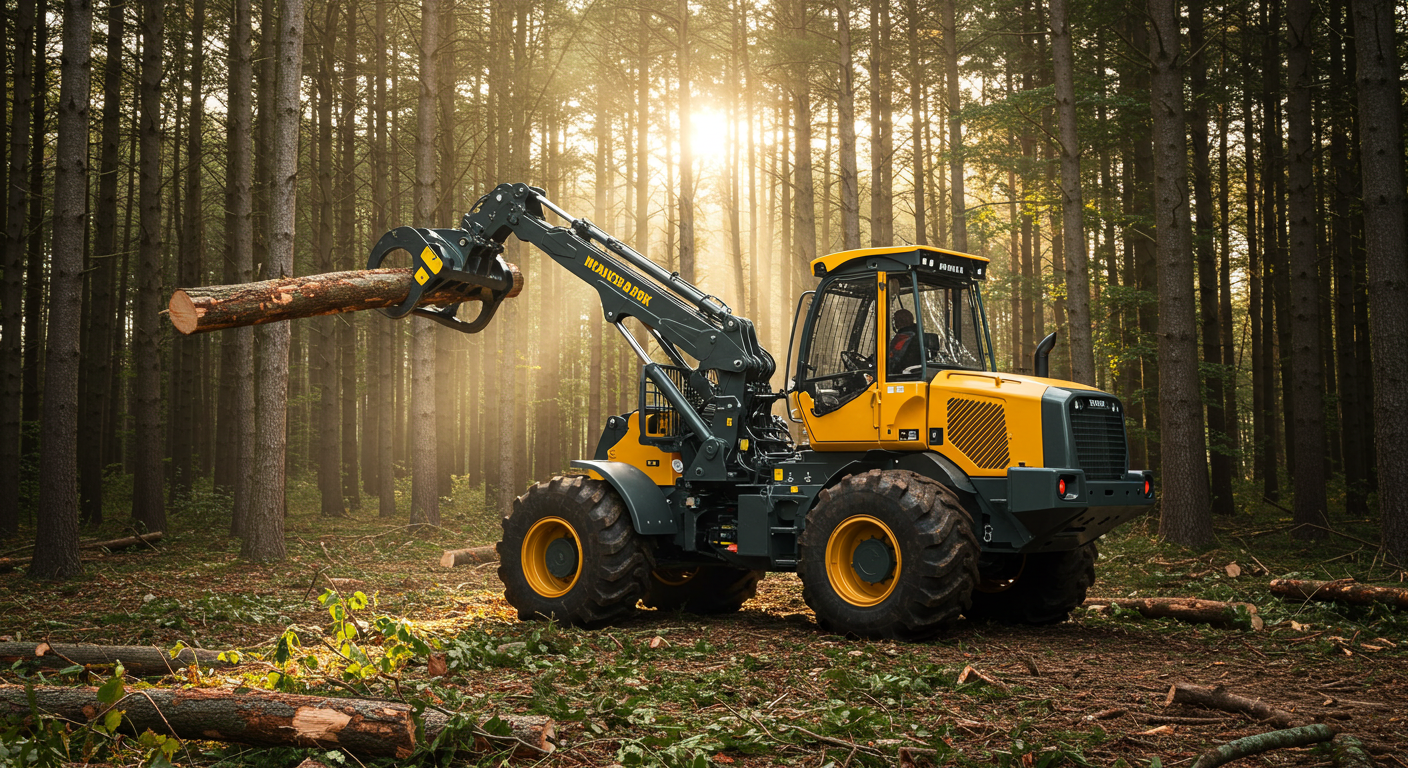Have you ever thought about how difficult it is to move a huge tree trunk? It is a job that requires not just raw strength, but also incredible precision. In the forestry world, this is a daily and routine operation that many professionals face. Fortunately, there is a powerful machine that makes everything easier, faster, and safer: the log loader.
This essential tool is vital for anyone who works with wood, whether in logging, processing, or transport. It helps reduce operator fatigue, speeds up manual labor significantly, and, most importantly, enhances workplace safety. Understanding how a log loader works and learning how to choose the right model is the first step toward optimizing your forestry or wood management operations.
What Are Log Loaders?
A log loader is a machine or an attachment specifically designed to lift, move, and stack logs and other heavy woody materials. It is also known in the industry as a “forestry crane” or “forestry loader.” When discussing the component that grips the logs, it’s typically referred to as a “hydraulic grab” or “grapple.”
Its main purpose is to make the transportation and positioning of logs easier, faster, and more automated. Without this specialized machine, such tasks would require immense manpower and become incredibly time-consuming and physically exhausting.
These machines are truly the heart of forestry, agricultural, and industrial woodworking activities. They make it possible to efficiently load timber onto trucks, feed sawmills or wood chippers, and organize log piles in a consistent, safe, and orderly fashion.
Log loader are so important because they dramatically improve productivity and operational efficiency. They turn slow, cumbersome tasks into quick and controlled operations. A good quality log loader can be a game-changing investment that pays for itself within a short time through increased efficiency and reduced labor costs.
Types of Log Loaders: Find the Right Model for Your Needs
The log loader market is vast and diverse. There are machines built to meet every need, from small-scale farming to massive commercial forestry operations. The right choice depends on how much wood you need to move, the terrain you’re working on, and your available resources. Let’s explore the main types.
Mounted Loaders: Flexibility for Small Jobs
Mounted loaders are the most compact and economical models. They attach directly to a tractor using a three-point hitch system. These are excellent if you require flexibility, as they can be quickly attached or detached. This allows your tractor to remain free for other agricultural or farm-related tasks.
They are an ideal solution for occasional tasks, such as moving firewood or assisting in small forestry businesses. However, being lighter and more portable, they are less robust and stable compared to other fixed models. This makes them less suitable for transporting very heavy logs or working in extremely rugged terrain.
Bracketed Loaders: Stability for Heavy-Duty Use
In contrast to mounted loaders, bracketed loaders are secured more permanently to the tractor through a durable steel structure that often passes underneath it. This provides significantly greater stability and structural strength.
These loaders are perfect for heavy-duty professional use and for moving larger volumes of timber. Their strength and dependability make them a preferred choice for demanding forestry operations. However, due to their fixed installation, they are harder to dismantle. This means your tractor becomes less versatile for other farm activities.
Trailer Loaders: Combining Loading and Transport
Trailer-mounted log loaders are mounted directly on a transport trailer and often come equipped with an independent hydraulic system. This type of machine combines both loading and transport capabilities in one convenient setup. It’s especially useful for moving logs from the forest directly to sawmills or collection sites.
A wide variety of models and pricing options are available for trailer loaders. The main drawback is that you must always haul the trailer along, even when you only need the loader function. Still, for many operations, the added convenience is well worth the compromise.
Forwarders: The Giants of Forestry Transport
Forwarders are large, self-propelled forestry vehicles designed to carry logs from the felling site to a roadside collection area. These machines come with a cab for the operator, a robust hydraulic crane with a grab, and powerful engines that enable operation in harsh forest environments. Their reach typically spans between 7 and 10 meters.
Thanks to advanced tire systems or half-tracks, they offer excellent maneuverability and traction, even in tough terrain. Their impressive load capacity ranges from 14 to 20 tons, making them indispensable for industrial-scale forestry operations. However, the price tag is equally massive—often exceeding €400,000.
Skidders: Raw Power for Logging
Skidders are powerful, self-propelled machines designed primarily to drag logs from the cutting site to collection points. They often come equipped with winches or grippers capable of handling even the most stubborn logs under difficult conditions.
These machines are built for durability and traction, operating in the toughest environments with ease. Like forwarders, skidders are specialized and high-cost machines, built to endure intensive forestry applications.
Such automation is ideal for industrial wood processing facilities that need a constant and reliable log flow. These systems significantly increase productivity and reduce the need for manual intervention.
Forestry Grapples: The Loader’s “Hand”
At the business end of the log loader is the forestry grapple—the attachment that grips and moves the logs. These vital accessories can be installed on tractors, excavators, and forwarders depending on the application.
Specialized types include sorting grapples, rock/wood grapples, 3-in-1 combination grapples, and even grapples with integrated chainsaws for on-the-go cutting. Operators place high importance on quality, as grapples often face intense wear and tear. Common issues include worn pins or broken tie rods, which can affect the machine’s precision and longevity.
Hand Tools: For Simpler, Smaller Jobs
While this guide focuses mainly on machines, it’s important to mention simple yet effective tools like log hooks, log tongs, or log pullers. These handheld devices are designed for lifting, carrying, or rotating smaller logs. They’re ideal for light work or when complementing larger machines on-site.
The broad range of available log loaders and accessories makes it clear that there’s no universal solution. Each machine type serves a unique purpose, tailored to specific work environments and operational needs. Knowing the differences is essential for making the right investment.
Key Features of a Log Loader
When you’re in the market for a log loader, there are several essential features to evaluate. These attributes will influence the machine’s performance, durability, and suitability for your specific tasks. Choosing wisely can have a lasting impact on productivity and equipment lifespan.
Load Capacity: How Much Can It Handle?
This refers to the maximum weight the log loader can lift at a time. It’s one of the most crucial specifications to consider. For instance, a small loader like the Deleks CRAB-3000 has a capacity of around 250kg, while larger forestry cranes can manage between 6 and 26 tonnes. High-end forwarders like the Tigercat 1075C can carry up to 20 tonnes.
Boom Reach: How Far Can It Extend?
Boom length determines how far the machine can extend its grapple without moving its base. Forwarders typically have a reach of 7–10 meters. Larger models, such as CAT’s material handlers, can reach up to 15 meters horizontally and 17 meters vertically. A longer reach increases efficiency by reducing repositioning time.
Hydraulic System: The Powerhouse of Movement
The hydraulic system is responsible for the loader’s movement and force. High-quality systems, with pressures up to 300 bar, deliver smooth and powerful operations. Safety features like block valves prevent uncontrolled movement during pressure loss, ensuring safer working conditions.
Material Quality: Built to Last
Expect a log loader to last between 10 and 15 years if built from quality materials. Seek machines using reinforced steel or high-tensile alloys for critical components. Higher-end grapples often use cast tie rods instead of welded ones for better durability and precise tolerances.
Compatibility and Mobility
Whether you need a fixed unit, trailer-mounted loader, or excavator integration, make sure the loader fits your existing fleet and job site. Consider track types—rubber for delicate terrain and iron for rough, heavy-duty environments.
Control Systems and Accessories
Modern loaders offer options ranging from manual controls to wireless joysticks and remote panels. Add-on accessories—such as buckets, manure kits, or integrated chainsaws—can make your loader far more versatile and cost-effective in the long run.
Understanding Log Loader Pricing
Prices range widely—from a few thousand to over half a million euros. Simpler mounted models cost around €2,000–€20,000, while mid-range equipment like tractor-mounted professional models can cost €20,000–€100,000, depending on use and condition. High-end forwarders and skidders can exceed €550,000.
Price is influenced by machine type, new vs. used condition, lifting capacity, brand reputation, and features like boom length and attachment options.
Maintenance Tips for Longevity
Proper care ensures the longevity and efficiency of your investment.
Daily Inspections: Check for wear, cracks, and leaks.
Pin and Rod Maintenance: Replace worn tie rods and pins promptly to prevent failure.
Hydraulic System Checks: Maintain fluid levels and inspect for leaks.
Regular Lubrication: Prevent friction damage by greasing pivot points.
Professional Inspections: Schedule periodic technician visits for deep diagnostics.
Parts Availability: Choose brands with good support and replacement part access.
Conclusion: An Investment in Efficiency and Safety
A log loader is more than just a piece of machinery—it’s a powerful partner in forestry, timber processing, and agricultural operations. By choosing the right type and maintaining it properly, you gain more than productivity—you ensure safety, reduce labor, and streamline your entire workflow.
Whether you’re managing a family farm or a large-scale timber operation, a well-chosen log loader becomes the backbone of your wood-handling system.

